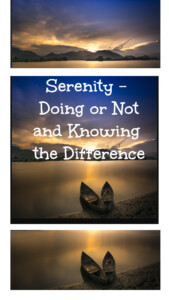Serenity – Doing or Not – and Knowing the Difference
 Serenity in being and doing.
Serenity in being and doing.
Serenity. In my Anabaptist heritage, there is a lot of doing that is a result of being. I grew up watching being and doing take place, and I witnessed serenity. Sometimes the being gets lost by the doing, but the quality of becoming who we should be is there, shimmering under the surface.
When there’s a catastrophe, a heartache, a sudden shift in the status quo, people want to know what they can do to help. They want to get in there and make a change. Doing is necessary and important. It helps bring survival, and facilitates healing.
Yet, sometimes, it’s good to go back to the basics of simply being.
When things happen that are out of our control, our tendency is to become angry or agitated, frustrated or forlorn, and wistful or wane. We thrash about, like horses on a treadmill – moving constantly, but going nowhere.
I’ve learned, in times like these, to stop and take a deep breath. Instead of jumping into the fray, I’ve learned to step back, evaluate, and pray. I’ve also learned that taking the time to assess and evaluate, without listening to everyone else first, will help me get a clear view of the situation and what I should do next.
Serenity prayer
That’s where this prayer is helpful. Written in a little stone stone cottage in Heath, Massachusetts by Reinhold Niebuhr (1892-1971), this prayer has become a creed for many organizations, including Alcoholics Anonymous (AA) and other recovery programs.
Many times we pray without thinking what we’re saying. Praying without practicing gets us nowhere, just like the horses working a treadmill.
This prayer asks for serenity first so that we can do what we should.
Serenity in acceptance
Serenity is the state of being calm, peaceful, and untroubled. To pray this prayer and mean it, I have to be out of turmoil and in calmness. This means I have to align my heart to calmness instead of being troubled.
Then I need to look at the problem I face.
Can I change it? If I can’t change what is happening, then I need to find my way to accept what is before me. This doesn’t mean I approve, applaud, or allow the circumstance to control me. It simply means I don’t waste valuable time and energy fighting the situation that is totally out of my control. Acceptance means I tolerate or submit to something unpleasant or undesired.
Serenity in courage
Courage to change the things I can. Making changes is not easy; sometimes it seems it’s not worth the hassle. Yet, if there are things I can change in a situation that are wrong, then I must. No matter the effort and the time, no matter the energy, I must have courage to change. Courage is strength in the face of pain or grief. Making changes isn’t easy; yet quitting because something is hard is not the way to live.
 Wisdom and the difference
Wisdom and the difference
Sometimes in the turmoil and mess of life, we confuse acceptance with courage. That’s when we need wisdom. Just what does it mean to have wisdom? Wisdom is the soundness of an action or decision with regard to the application of experience, knowledge, and good judgment.
Don’t try to change what can’t be changed. Step out in courage to change what you can change, no matter how hard it is. When you’re unsure, ask God to give you wisdom. He will show you if you need acceptance or courage. He knows the difference, and He wants you to know it, too.
Only when you know the difference can you move forward. When you know the difference, you’ll know which path to take. Being and doing together are a sign of serenity.
It’s the best way to live.

Photo credits: David Mark and Quang Nguyen vinh, respectively by Pixabay





